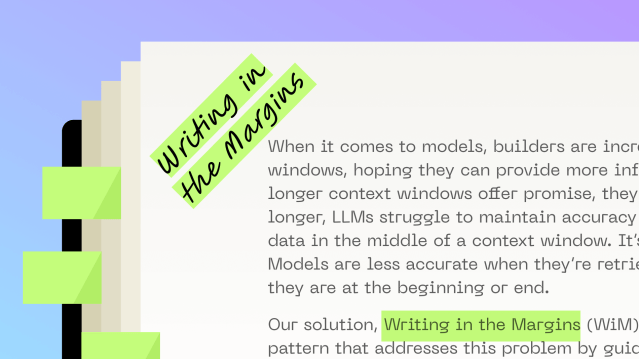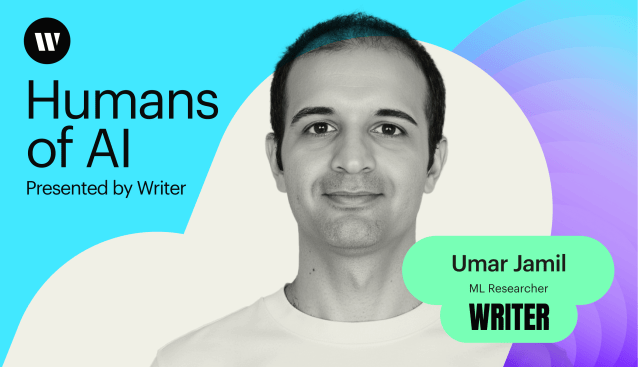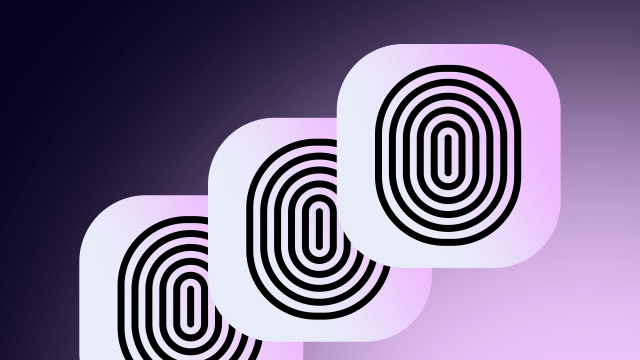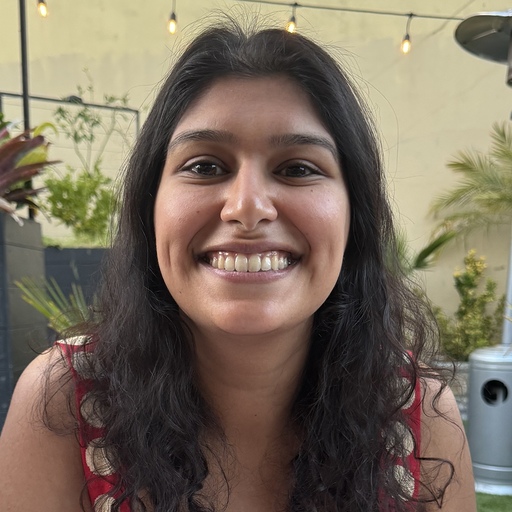Humans in the loop
– 12 min read
The accidental algorithm: Melisa Russak, AI research scientist at WRITER
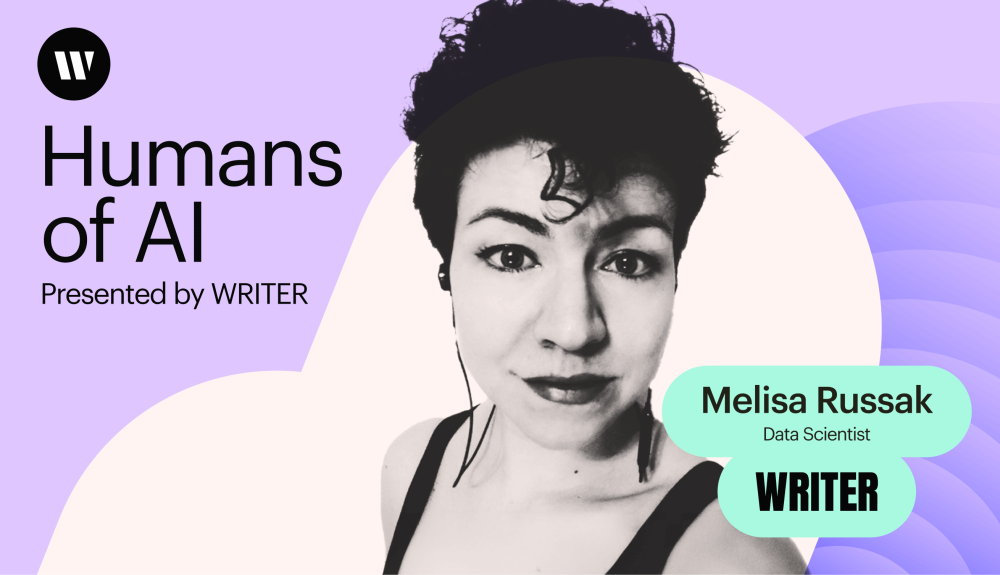
When we think of AI breakthroughs, our minds naturally drift to Silicon Valley labs or MIT research centers. But this conventional thinking might be exactly what limits true innovation. Because sometimes the most revolutionary discoveries come not from expertise, but from the perfect combination of curiosity and naivety — from someone who doesn’t know what’s “impossible” or how people typically do things.
Meet Melisa Russak, our latest guest on Humans of AI. She’s a research scientist at WRITER who discovered that sometimes the best way to innovate is to have no idea what you’re doing.
Her story reveals a counterintuitive truth — in a field obsessed with staying current on the latest research, some of the most profound discoveries come from approaching problems with completely fresh eyes. Melisa’s journey shows how curiosity-driven exploration can outpace conventional expertise — and why the future of AI might depend more on asking better questions than knowing all the answers.
- Melissa’s journey started in Chengdu, where she combined her study of pure mathematics with Chinese — which helped her develop cross-domain pattern recognition skills.
- Melisa’s first foray into AI was a project to help high school students recognize handwritten Chinese characters, leading her to independently develop k-means clustering.
- She’s currently working on a project to use AI to analyze her digital footprint and predict her actions, raising philosophical questions about free will and human behavior.
- She connects her philosophical questions about self-analysis to her research into self-evolving models that learn through self-reflection.
- At WRITER, Melisa emphasizes the importance of constraints and a human-first approach to AI development, pioneering synthetic data generation and the “vibes test” to ensure practical usability.
- Her work on the “vibes test” is formalized in research she worked on called Writing in the Margins, which focuses on how AI can better understand messy, real-world human instructions.
Breaking free from mathematical abstractions
Melisa’s AI journey began in Chengdu, where she was studying pure mathematics but growing increasingly frustrated with its limitations. The abstract nature of mathematical research left her craving something more tangible. She wanted to see her progress compounded visibly, day by day.
“Mathematics is, it’s purely abstract. So while I study mathematics, I was discovering that a part of me is not developing,” Melisa explains. “Like in mathematics, I have a feeling like there is this thing, like you can spend 10 hours thinking about the math problem and have no results. You can go to Chinese and you can spend those 10 hours learning Chinese songs, right? So you’re going to see the progress.”
Her unconventional solution was to study Chinese alongside her mathematical studies — not for career reasons, but simply because it felt like what she needed.
“So I just chose something maximally different from mathematics, and that was Chinese,” she says. “I need to admit that Chinese, because it’s challenging, right? It’s completely different system.”
By embracing linguistic complexity, she was also developing the cross-domain pattern recognition that makes for great AI researchers. If this story sounds familiar at all, that’s because WRITER machine learning researcher Umar Jamil also took it upon himself to learn Mandarin.
Stumbling onto machine learning in a Chinese classroom
After becoming a high school math teacher, Melisa watched her students struggle with handwritten Chinese characters and saw an opportunity. She had recently taught herself programming through ActionScript. Initially, it was just to create better learning tools.
What started as a simple teacher’s project to help students recognize handwritten characters turned into something much bigger. Without realizing it, she was tackling one of the core problems in computer vision and machine learning.
“Of course, at this point you have no notion of AI, right? You never came across machine learning, this phrase,” Melisa says.
Somehow, working purely from first principles, she did build a functioning classification system.
“So this is when it all started,” she explains. “I think that was my first data science project, my first data science job that really pushed me into discovery.”
Melisa’s “accidental” algorithm was k-means clustering, a fundamental machine learning technique that had been around for years. But here’s the thing, Melisa didn’t know that. She’d stumbled upon it through sheer curiosity and a willingness to tinker. And that’s exactly what led to her breakthrough.
Reinventing neural networks to answer “Who am I?”
Lightning struck twice when Melisa became fascinated with a deeply personal question — could software help her understand herself better? She wanted to analyze her digital footprint — everything she viewed, read, and interacted with online — to discover patterns she might not have noticed consciously.
“Maybe you have this problem, like when you wake up in the morning and you have this blank page,” Melisa says. “You’re asking questions like, what did I want to do today? Even before the first coffee.”
This existential curiosity led her to another fundamental AI problem. How do you teach computers to understand both text and images? Working with linguists, she dove into what we now call representation learning and embeddings.
“And of course, if you try to do that, you naturally come into machine learning,” Melisa says. “This is exactly machine learning because you see text, right? Text is simple. I mean like relatively simple, but they also just see pictures, right?”
Once again, Melisa had unknowingly recreated core concepts that power modern AI systems. She was reinventing neural networks, embeddings, clustering algorithms — the entire foundation of modern AI — all because she wanted to know more about herself.
Her story raises the question — how often do we think we’re being original when we’re walking a path that others have already carved? The answer, it turns out, is more often than we think. But sometimes it’s that ignorance that leads to breakthrough and enlightenment.
Embracing the power of ignorance
This story highlights a paradox at the heart of innovation — the more we know about a subject, the harder it can be to see new solutions. And the more we learn, the more we become trapped in our own assumptions and biases. Melisa’s advice to researchers is to approach problems with fresh eyes before diving into existing literature.
“If you have a topic, before you start working on a topic, think about how you would frame it yourself,” she says. “Because once you start reading papers, you will converge to what they actually, how they frame the problem. And it’s very difficult to escape from that box once you’re in the box.”
From Melisa’s perspective, expertise can be both an asset and a constraint. Sometimes, not knowing the “right” way to solve a problem is exactly what allows you to find a new solution.
Pushing philosophy to its algorithmic limits
Now, Melisa’s curiosity has led her to perhaps her most ambitious project yet. She’s using AI to question the nature of free will itself. She wants to train a model on every aspect of her experience and see if it can predict her future actions.
“So imagine that you collect all artifacts that you see, all pictures like even sound, everything that you can collect, even conversation with other human beings,” Melisa explains. “So this is your input, right? As a human being.”
Doing this could result in a very unsettling realization for some. If an AI trained on all of your experiences can predict your next action, what does that say about free will? Are we just very sophisticated algorithms ourselves, following patterns we’re not even aware of?
It’s the ultimate evolution of her original question — “Who am I?” — taken to its logical extreme using the tools of artificial intelligence.
This personal, philosophical quest finds a direct professional parallel in her research at WRITER. In a project exploring self-reflection for LLM reinforcement learning, she investigates how AI models can analyze their own outputs to improve and “self-evolve.” It’s the same principle of learning from one’s own experience, applied not to a human, but to AI itself, demonstrating how her deep curiosity about the nature of identity directly fuels her technical breakthroughs.
Thriving under constraints at WRITER
It’s evident that approaching problems — whether old or new — in unconventional ways is the key to real progress. So what if we could find a way to tap into the same kind of curiosity and naivety that drove Melisa’s early breakthroughs? What if we could create an environment that encourages accidental discovery, even in the face of established knowledge?
For Melisa, the answer lies in embracing constraints. When she joined WRITER, she was tasked with building a natural language processing (NLP) system from scratch — without any customer data. Most researchers would have seen this as a deal-breaker, but Melisa saw it as an opportunity.
“What’s excellent about this place is, constraints at the very beginning,” she says. “We don’t use customer data. So, how do I develop a system without data? And at first, you can be angry, right? Because ‘Oh no, this is unfair. I don’t have the data. I can’t create a solution.’ And then you think about this, ‘Oh, this is an excellent constraint.”
Pioneering synthetic data generation before it was cool
As it turned out, the lack of data was exactly what Melisa needed to tap into her creative potential. With no preconceived notions or established solutions to fall back on, she had to think outside the box.
She started by trying to generate synthetic data from scratch, essentially training a model to create data that didn’t exist. It was ambitious, but it worked. The resulting model was stronger and more generalizable than anything she could have built using existing data. She was pioneering synthetic data generation years before it became an industry buzzword — another case of necessity driving breakthrough thinking.
“So actually, the first model that we created was to generate the data,” Melisa recalls. “We train the model to generate the data. And I think that was an amazing idea because I would never come up with this if not given those constraints.”
Testing for vibes, not just benchmarks
WRITER’s approach to AI development challenges industry orthodoxy. While most companies obsess over benchmark performance, WRITER prioritizes something harder to measure but more important. Does AI work for real people doing real work?
“Everyone in the industry is relying on benchmarks, that’s true,” Melisa says. “But the benchmark is like a cherry-picked use case. There is one piece that is missing in all of that testing, and it’s very time-consuming because it’s asking a human being, could you please use that model in production?”
WRITER’s secret weapon is what Melisa calls the “vibes test” — a human-centered evaluation that goes beyond metrics. “We always say that the vibes test is the most important. Like, after you satisfy all of those benchmarks, you go and do the vibes check.”
This human-first approach led to some fascinating discoveries. Melisa and her team developed FailSafeQA, a benchmark that tests how AI models handle the messy reality of human interaction — incomplete instructions, confusing context, and all the curveballs real users throw at AI systems.
What they found was counterintuitive — the models that seemed “smarter” in traditional tests were often less helpful in practice. Sometimes, the most sophisticated reasoning can get in the way of simply being useful. WRITER’s Palmyra-Fin-128k emerged as the sweet spot — sophisticated enough to understand complex requests, but compliant enough to actually help users get things done.
This human-first evaluation philosophy is a cornerstone of her work, formally captured in research she pioneered called Writing in the Margins. The project investigates how AI models handle instructions that aren’t perfectly formatted — the kind of notes, asides, and “in the margins” context that real people use every day. It’s a concrete example of moving beyond sterile benchmarks to solve for the messiness of human-AI collaboration — ensuring models aren’t just powerful, but genuinely practical and useful.
Reflecting on accidental algorithms and intentional innovation
Looking back, Melisa uses the language of AI to describe her own life trajectory.
“Those tokens that happened before are very important for the current token,” she says. “If you change anything in past tokens, you would diverge from the trajectory that you’re at right now.”
Her story reveals something profound about innovation in AI and beyond. The most significant breakthroughs often come not from following established playbooks but from approaching problems with genuine curiosity and fresh perspectives. At WRITER, she’s found an environment that doesn’t just accept this kind of thinking — it systematically cultivates it.
“Sky is the limit, right? Even with the current technology, we can go very, very far,” Melisa says. “So it’s only about the imagination.”
Sometimes the best way to push a field forward is to start by not knowing what everyone else already knows. In an industry obsessed with the latest techniques and biggest datasets, her story is a reminder that curiosity, constraints, and a willingness to start from scratch can be the most powerful tools of all.
If Melisa’s story, curiosity, and drive resonate with you, know that at WRITER we’re on the lookout for other people with similar ambitions. Check out our career page and join a team that thrives in an environment where accidental discoveries can happen on purpose.
Want to hear more stories from the humans working at the crossroads of business and generative AI? Subscribe to Humans of AI wherever you listen to podcasts.
